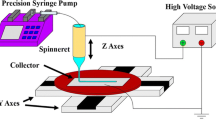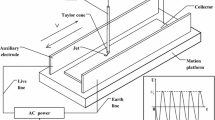Abstract
In this paper, shaped fibers which are especially useful for radiative cooling have been firstly deposited by Electrohydrodynamic direct-writing based on Micro-Weissenberg effect (MWE). At first, The process of pumping viscoelastic fluids (polyethylene oxide) in micro-tube (non-circle nozzle) based on Micro-Weissenberg effect has been studied to reveal the mechanism of Micro-Weissenberg effect. We have found that the pumping based on MWE have obvious periodic fluctuation when the flow rate is small. Then the process of steel pins without small diameter pipes pumping viscoelastic fluid which is a continuous, less wall and controllable pumping manner have been studied in detail. It is found that the pumping based on MWE mainly stem from an interesting capillarity between two pins and the viscoelasticity of fluid. So compare with the traditional Electrohydrodynamic direct-writing, the shaped fibers have been more easily deposited by Electrohydrodynamic direct-writing based on MWE due to the capillarity and the shear thinning in Micro-Weissenberg effect.




Similar content being viewed by others
Data availability
The authors confirm that the data supporting the findings of this study are available within the article.
References
K. Weissenberg, A continuum theory of rheological phenomena. Nature 159, 310–311 (1947)
J.M. Dealy, T.K.P. Vu, The Weissenberg effect in molten polymers. J. Nonnewton. Fluid Mecha. 3, 127–140 (1978)
B. Debbaut, B. Hocq, On the numerical simulation of axisymmetric swirling flows of differential viscoelastic liquids: the rod climbing effect and the Quelleffekt. J. Nonnewton. Fluid Mech. 43, 103–126 (1992)
A.S. Lodge, J.D. Schieber, R.B. Bird, The Weissenberg effect at finite rod-rotation speeds. J. Cherm. Phys. 88, 4001–4007 (1988)
H.G. Muller, Weissenberg effect in the thick of the hen’s egg. Nature 189, 213 (1961)
G.S. Beavers, J.Y. Yoo, D.D. Joseph, The free surface on a liquid between cylinders rotating at different speeds. Rheologiea Acta 19, 19–31 (1980)
D.D. Joseph, R.L. Fosdick, The free surface on a liquid between cylinders rotating at different speeds. Arch. Rational Mech. Anal. 49, 322–380 (1972)
X.-L. Luo, Numerical simulation of Weissenberg phenomena the rod-climbing of viscoelastic fluids. Comput. Methods Appl. Mech. Engrg. 180, 393–412 (1999)
S. Odenbach, T. Rylewicz, H. Rath, Investigation of the Weissenberg effect in suspensions of magnetic nanoparticles. Phys. Fluids 11, 2901–2906 (1999)
J. Lyklema, Fundamentals of interface and colloid science (Academic press, New York, 1995)
A.L. Margeret, C.J. Stephen, Electrokinetic fluid control in two-dimensional planar microfluidic devices. Anal. Chem. 79, 7485–7491 (2007)
E.B. Bagley, H.J. Duffey, Recoverable shear strain and the barus effect in polymer extrusion. J. Rheol. 14(4), 545–553 (1970)
D. Sun, C. Chang, S. Li, L. Lin, Near-field electrospinning. Nano Lett. 6, 839–842 (2006)
G. Zheng, W. Li, X. Wang, D. Wu, D. Sun, L. Lin, Precision deposition of a nanofibre by near-field electrospinning. J. Phys. D 43(41), 415501 (2010)
G. Zheng, Y. Pei, X. Wang, J. Zheng, D. Sun, Electrohydrodynamic direct-writing of conductor-insulator-conductor multi-layer interconnection. Chin. Phys. B. 23(6), 066102 (2014)
S.J. Kim, Y.C. Wang, Concentration polarization and Non linear electrokinetic flow near a nanofluidic channel. Phys. Rev. Lett. 99, 044501 (2007)
Y. Zhen, L.G. Anthony, Electrokinetic transport and separations in fluidic nanochannels. Electrophoresis 28, 595–610 (2007)
C. Quilliet, B. Berge, Electrowetting: a recent outbreak. Curr. Opin. Collid. Interface Sci. 6(1), 34–39 (2001)
F. Mugele, J.C. Baret, Electrowetting: From basis to application. J. Phys. Condens. Matter 17(28), R705–R774 (2005)
Z. Dong, L. Wu, N. Li, J. Ma, L. Jiang, Manipulating Overflow SeparationDirections by Wettability Boundary Positions. ACS Nano. 9, 6595–6602 (2015)
X. Mei, Q. Chen, s wang et al., Microscale Weissenberg effect for high-viscosity solution pumping at the Picoliter Level. Nanoscale 10(15), 7127 (2018)
S. Wang, X. Mei, J. Cao, D. Sun, S. Wang, The preparation of graphene/polyethylene oxide/sodium dodecyl sulfate composite humidity sensor via electrohydrodynamic direct-writing. J. Phys. D 52, 175307 (2019)
S. Wang, W. Wang, L. Yu, Z. Zhan, D. Sun, The fast fabrication of flexible electronic devices of graphene composites. Nanotechnology 27, 31LT01(6pp) (2016)
M. Ma, F. Grey, L. Shen, M. Urbakh, W. Shuai, J.Z. Liu, Y. Liu, Q. Zheng, Water transport inside carbon nanotubes mediated by phonon-induced oscillating friction. Nat. Nanotechnol. 10, 692–695 (2015)
B. Zhu, W. Li, Q. Zhang, D. Li et al., Subambient daytime radiative cooling textile based on nanoprocessed silk. Nat. Nanotechnol. 16, 1342–1348 (2021)
Y. Zhai et al., Scalable-manufactured randomized glass-polymer hybrid metamaterial for daytime radiative cooling. Science 355, 1062–1066 (2017)
S. Wang, X. Mei, S. Wang et al., Micro/nanofluidic transport by special fibers deposited by electrohydrodynamic direct-writing. Mater. Des. 225, 111518 (2023)
Acknowledgements
This work is supported by Natural Science Foundation of Chongqing (No. cstc2019jcyj-msxmX0715, CSTB2022NSCQ-MSX1199), Natural Science Foundation of Anhui Province of China (No. KJ2015A281), The Science and Technology Project Affiliated to the Education Department of Chongqing(KJZD-K202201404).
Author information
Authors and Affiliations
Corresponding author
Ethics declarations
Conflict of interest
The authors declare no conflict of interest.
Additional information
Publisher's Note
Springer Nature remains neutral with regard to jurisdictional claims in published maps and institutional affiliations.
Rights and permissions
Springer Nature or its licensor (e.g. a society or other partner) holds exclusive rights to this article under a publishing agreement with the author(s) or other rightsholder(s); author self-archiving of the accepted manuscript version of this article is solely governed by the terms of such publishing agreement and applicable law.
About this article
Cite this article
Luo, Y., Xu, B. & Wang, S. Electrohydrodynamic direct-writing shaped fibers via pumping based on Micro-Weissenberg effect. Appl. Phys. A 129, 136 (2023). https://doi.org/10.1007/s00339-023-06418-2
Received:
Accepted:
Published:
DOI: https://doi.org/10.1007/s00339-023-06418-2




